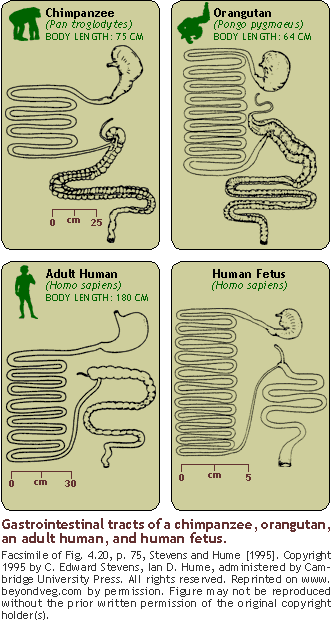![]()

|
|
 |
| Overview of Gut (Digestive System) Morphology in Primates and Humans |
Diet categories in comparative proofs are typically narrow. The comparisons made are relatively simplistic, and the thinking process involved is also usually rather narrow: herbivores vs. carnivores vs. humans (and omnivores are sometimes added to the list). In referring to narrow thinking here, we mean that the comparative proofs neatly define their dietary categories in a narrow way, and ignore the fact that in nature, diets are usually not strict (i.e., "pure" diets are rare). The comparison of digestive system features comprises the second major component of many comparative proofs
Other shortcomings of typical comparative proofs. Needless to say, the comparative proofs suffer from many of the limitations identified in previous sections--
Preview of this section. Instead of listing the numerous claims of Mills and the other proofs, and analyzing them directly for possible shortcomings, this paper takes a different approach. First, we'll review the work of Milton [1987], as it nicely illustrates that the human gut is (nearly) unique--
Milton [1987,
Additionally, Milton [1987] discusses two primates whose gut proportions appear to roughly match those of humans:
GO TO NEXT PART OF ARTICLE
Return to beginning of article
Back to Research-Based Appraisals of Alternative Diet Lore
![]()
Humans are unique, and the human gut is (nearly) unique
![]()
Since we will be comparing the gut (digestive system) of humans with other animals, especially primates, it is appropriate to begin with an illustration that provides a comparison.
When compared to those of most other mammals, the relative proportions of the human gut are unusual (my calculations, using data from Chivers and Hladik [1980], and Hladik [1967]).
Human gut small compared to apes. Observing that human gut proportions are different from those found in carnivores, herbivores, swine (an omnivore), and even most other primates, including the anthropoid apes, Milton [1987,
Gut characteristics reflect dietary quality. Like humans, Capuchin monkeys and savanna baboons make extensive use of their hands for pre-
Rather, it appears to represent similar adaptive trends in gut morphology in response to diets made up of unusually high-
The plasticity (or elasticity) of the human gut--
![]()
(Quantitative Analysis of Gut Morphology in Primates and Humans)
SEE TABLE OF CONTENTS FOR:
PART 1 PART 2 PART 3 PART 4 PART 5 PART 6 PART 7 PART 8 PART 9
GO TO PART 1 - Brief Overview: What is the Relevance of Comparative Anatomical and Physiological "Proofs"?
![]()
GO TO PART 2 - Looking at Ape Diets: Myths, Realities, and Rationalizations
![]()
GO TO PART 3 - The Fossil-Record Evidence about
![]()
GO TO PART 4 - Intelligence, Evolution of the Human Brain,
![]()
GO TO PART 5 - Limitations on Comparative Dietary Proofs
![]()
GO TO PART 6 - What Comparative Anatomy Does and Doesn't Tell Us about
![]()
GO TO PART 7 - Insights about Human Nutrition & Digestion from Comparative Physiology
![]()
GO TO PART 8 - Further Issues in the Debate over Omnivorous vs. Vegetarian Diets
![]()
GO TO PART 9 - Conclusions: The End, or The Beginning of a New Approach to